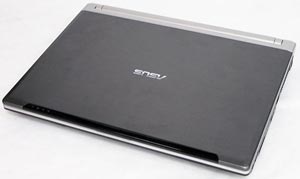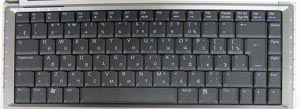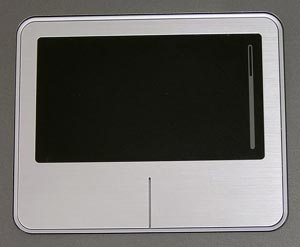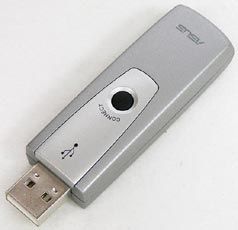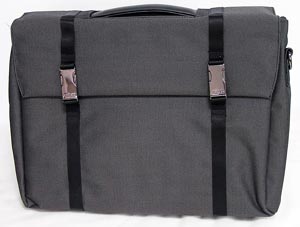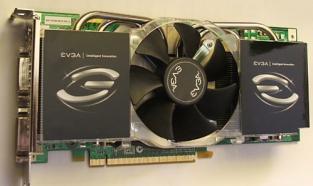ASUS W3H00V REVIEW NOTEBOOK PERFORMANCE BENCHMARK
![]()
|
|
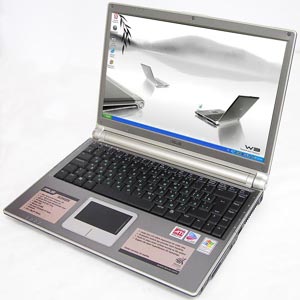 |
||||||||||||
| Posted:2006-06-09 By notebook review Number of View:208801 |
|||||||||||||
By :notebook review Posted:2006-06-09
One of the first notebooks in its class, the ASUS W3H00V has been on the market for long, yet still stands among the best products available. ASUS managed to find a perfect balance of eye-pleasing design, good functionality and performance and didn’t introduce any big changes since the initial release of this model.
The W3H00V model represents the ASUS style at its highest – the designers did an excellent job. The lid is made of metal, just as it must be in an expensive notebook, and has a rather rare coloring:
Few notebooks can boast a metal lid, though it is practical – it superbly protects the display against physical damage. Pass-through indicators are placed on the black decorative strip in the notebook’s front:
When the lid is closed, these indicators report the notebook’s status to you.
The front panel is empty as is typical of ASUS notebooks.
The manufacturer only built speakers into it. There’s nothing on the back panel besides the battery.
The battery fastening is somewhat slack, which is rather disappointing in a notebook you pay so much money for. This has no effect on the operation of the computer, yet the overall impression is somewhat spoiled. The notebook’s I/O connectors are all placed on its side panels:
On the left side, there are two closely placed USB 2.0 ports, an output for an external monitor, modem and LAN ports, and a DVD-burner. In the middle of the right panel, there is a video output, one more USB 2.0 port, and a vent opening.
The Power-On button is designed in an original way: it’s built into the screen hinge. Make sure you don’t press it accidentally while carrying the notebook. The keyboard is ordinary:
This is a regular notebook keyboard with an addition of text navigation buttons on the right. The arrow keys are not very handy due to their smaller size. There are two groups of extra keys on both sides of the keyboard.
The left group includes media player controls and an Instant-On mode button. The group on the right is comprised of two instant-launch keys, wireless adapters switches, and a button to disable the touchpad.
This solution is all right aesthetically, but not ergonomically. The buttons may be pressed accidentally when you’re moving the notebook around with the lid open. Indicators of keyboard status, Bluetooth activity and Instant-On mode are implemented as a narrow strip…
…and are hard to see under bright external lighting. Users of ASUS notebooks should be familiar with this touchpad:
There’s a damping pad on the hard disk drive compartment and a pocket for your visiting card – these things allow telling an ASUS notebook from any other brand. And here’s the battery with slack fastening:
Its parameters match its size:
Among bonus accessories, there is a cute wireless optical mouse…
This rack is installed instead of the optical drive. A bag to carry the notebook in is included, too:
That’s not the best of bags, but it should suffice for carrying the notebook and its accessories from your car to your office. I’d like to compliment ASUS as the single company is this review to be so caring about the future owner of its notebook. Moreover, ASUS keeps within a price limit in which other manufacturers offer much less. The performance and battery life of this notebook will be discussed later on, but running a little head, I want to say that it’s all right with these parameters of the W3H00V, too. The overall verdict is that the notebook and its accessories are indeed superb. This is one of the best solutions in its class and is something other manufacturers have yet to reach. You must consider this model if you’re looking for your notebook in this class. However, being among the best doesn’t mean being the best. There is a model in this review that can bear comparison with the W3H00V. Read on to learn its name! PerformanceFirst I checked the notebooks in Business Winstone 2004 and Content Creation Winstone 2004 benchmarks ASUS W3H00V winstone benchmarkAnd here are the results produced by PCMark04: ASUS W3H00V pcmark performanceThe results of the Photoshop CS are indicative of the overall performance of the CPU, platform and hard drive: ASUS W3H00V adobe photoshopThe well-balanced LW40 is almost as fast as the two notebooks on the new platform. Other notebooks are slower. The two slowest models shouldn’t be used to run such applications at all – they are only capable of performing office tasks like processing text and spreadsheets, browsing the Web, etc. The next test shows what you can expect from these notebooks in gaming applications: ASUS W3H00V gaming benchmarkperformed this test using the maximum display resolution of each notebook, except for the LG T1 (I used 1280x800 with it because 1440x900 would have been too much for its integrated graphics core). The Acer TravelMate 3222WXMi is the best and can cope with modern games if you don’t use the highest graphics quality settings. Among other notebooks, only models with the X600 are interesting. The Samsung X11 is second after the TravelMate 3222WXMi but I doubt it’s going to be that fast in real games. I also published the results of the CPU subtest to show you that 3DMark03 favors the Centrino Core Duo platform. This is indicated by the Samsung X11’s results. This platform is the most promising one when it comes to games, considering that all the leading game developers have confirmed support for dual-core processors in their upcoming products. And now, the results of the most important test: I put the results the notebooks achieved in Reader’s mode and under maximum load into one diagram because the difference between the two is indicative of how well the manufacturer set up the power-saving parameters. The Sony VGN-FJ1SR looks best here as it yields you its full computing power under max load but is very economical in Reader’s mode. Besides the Sony, there are two more leaders: LG’s T1 with a high-capacity battery and an L series Core Duo processor which features low power consumption, and ASUS W3H00V. The latter proved to be a bit of a cheater, though. Even under max load with the portable/laptop power management scheme selected this notebook never increased its CPU frequency higher than 1.3GHz. It’s all clear with the first two diagrams, but then there are some things I’d want to single out. The LW40 is very fast in the memory test; it’s the best Centrino-based notebook I’ve seen in this benchmark. The Acer TravelMate 3222WXMi is unrivalled in the graphics subsystem test just because it has the fastest graphics adapter among the tested notebooks. Nvidia’s GeForce Go 7400 is downright disappointing. If you need fast graphics, buy a notebook that has dedicated graphics memory. Graphics subsystems of other kind (with such suffixes as TC, HM) are not much better than integrated graphics and cannot ensure high performance in 3D. In the disk subsystem test the notebooks rank up according to the spindle rotation speed of the hard drive they use. Other related notebook: Acer TravelMate 3222WXMi notebook review
we would be happy to answer for your question . if you have suggestion or comment
regarding this review our support would be glad to help just join our forum and ask u will get the best answer
to discuss check our forum section :-) RATE THIS REVIEW | |||||||||||||
![]()

7600gt review
7600gt is the middle card range.
We already benchmarked this video card and found that ...

 geforce 8800gtx and 8800gts
geforce 8800gtx and 8800gts  Xtreview software download Section
Xtreview software download Section  AMD TURION 64 X2 REVIEW
AMD TURION 64 X2 REVIEW  INTEL PENTIUM D 920 , INTEL PENTIUM D 930
INTEL PENTIUM D 920 , INTEL PENTIUM D 930  6800XT REVIEW
6800XT REVIEW  computer hardware REVIEW
computer hardware REVIEW  INTEL CONROE CORE DUO 2 REVIEW VS AMD AM2
INTEL CONROE CORE DUO 2 REVIEW VS AMD AM2  INTEL PENTIUM D 805 INTEL D805
INTEL PENTIUM D 805 INTEL D805  Free desktop wallpaper
Free desktop wallpaper  online fighting game
online fighting game  Xtreview price comparison center
Xtreview price comparison center 

- The new version of GPU-Z finally kills the belief in the miracle of Vega transformation
- The motherboard manufacturer confirms the characteristics of the processors Coffee Lake
- We are looking for copper coolers on NVIDIA Volta computing accelerators
- Unofficially about Intels plans to release 300-series chipset
- The Japanese representation of AMD offered monetary compensation to the first buyers of Ryzen Threadripper
- This year will not be released more than 45 million motherboards
- TSMC denies the presentation of charges from the antimonopoly authorities
- Radeon RX Vega 64 at frequencies 1802-1000 MHz updated the record GPUPI 1B
- AMD itself would like to believe that mobile processors Ryzen have already been released
- AMD Vega 20 will find application in accelerating computations
- Pre-orders for new iPhone start next week
- Radeon RX Vega 57, 58 and 59: the wonders of transformation
- ASML starts commercial delivery of EUV-scanners
- The older Skylake processors with a free multiplier are removed from production
- Meizu will release Android-smartphone based on Helio P40
- AMD Bristol Ridge processors are also available in American retail
- The fate of Toshiba Memory can be solved to the next environment
- duo GeForce GTX 1080 Ti in GPUPI 1B at frequencies of 2480-10320 MHz
- New Kentsfield overclocking record up to 5204 MHz
- Lenovo released Android-smartphone K8



computer news computer parts review Old Forum Downloads New Forum Login Join Articles terms Hardware blog Sitemap Get Freebies


